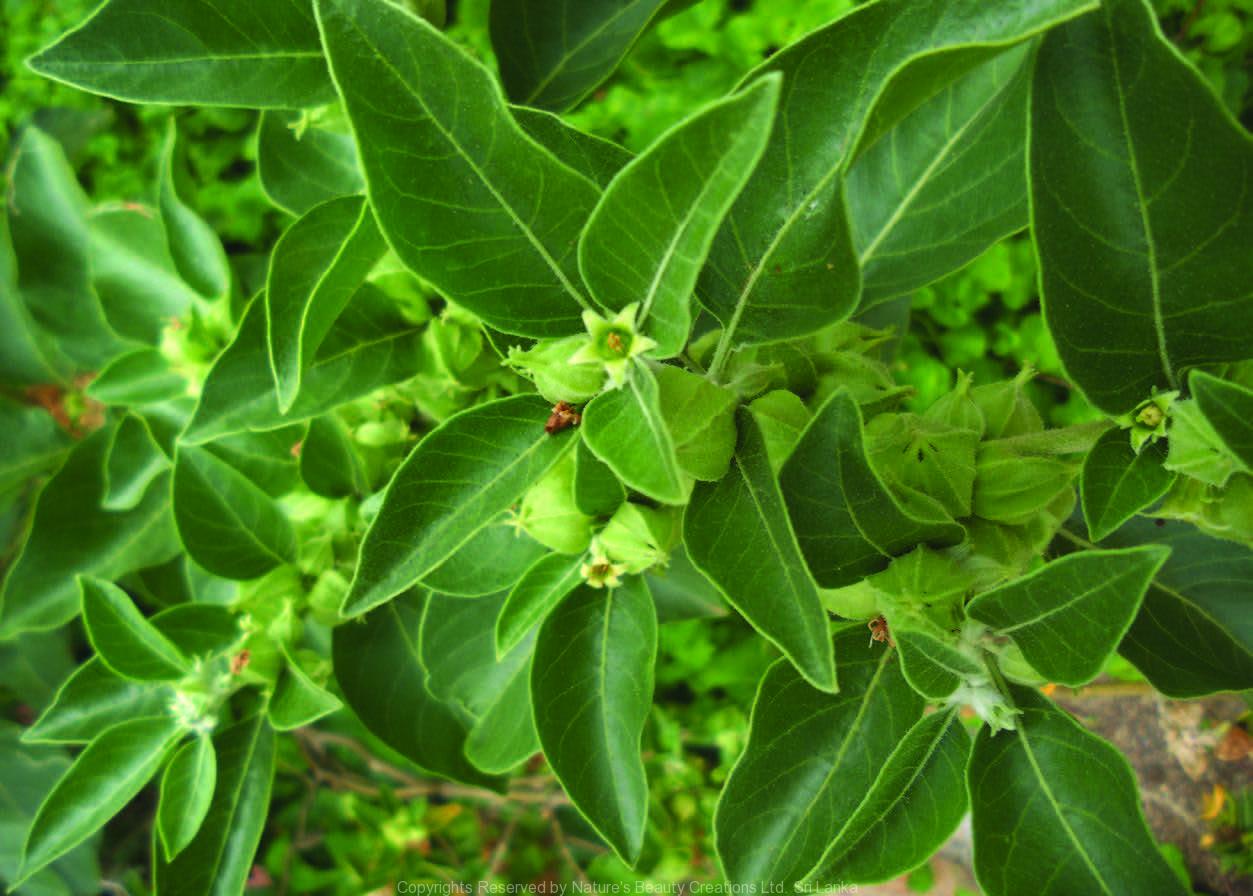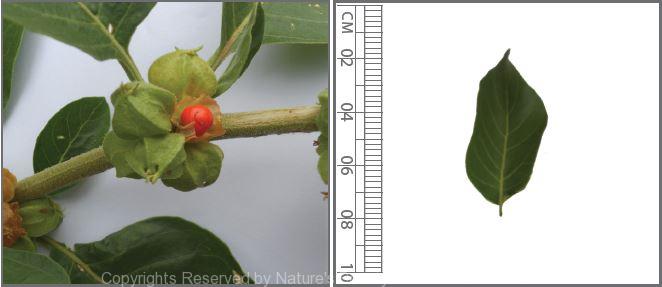

Traditional Knowledge
Useful plant parts :
Whole plant, root and leaf
Uses in traditional medicine :
- Root powder mixed with ghee is prescribed to treat sexual weaknesses
- It is a tonic, alterative, sexual stimulant and an aphrodisiac
- Used in pulmonary tuberculosis, insanity, apoplexy, nervous diseases, painful swellings, gangrenous rectitis, syphilis, diarrhoea, nausea and rheumatism
Scientific Research
Chemical constituents:
Chlorinated steroidal lactone, diepoxy withanolide and withaferin A from aerial parts; glycoproteins and glycowithanolides: sitoindosides I–X from roots
Bioactivity :
Aqueous alcohol extract of roots and leaves: antioxidative, antiapoptotic, cardioprotective, antibacterial; acidic glycoprotein: phospholipase inhibitor; alcoholic extracts of roots: antimicrobial, anticancer, antiproliferative, stimulate thyroid function in males; chlorinated steroidal lactone, diepoxy withanolide and withaferin: cytotoxic against cancer cells
Clinical:
Roots have potential hypoglycaemic, diuretic and hypocholesterolaemic effects; Ethanol extract of plant has reported anxiolytic activity; Plant improves the cognitive capacity in bipoler disorder and the semen quality of infertile males
References : Ahmad, M. K. et al., (2010), Withania somnifera improves semen quality by regulating reproductive hormone levels and oxidative stress in seminal plasma of infertile males, Fertility and Sterility, 94(3), 989–996. Andallu, B. and Radhika, B., (2000), Hypoglycemic, diuretic and hypocholesterolemic effect of winter cherry (Withania somnifer Dunal) root, Indian Journal of Experimental Biology, 38(6), 607-609. Andrade, C. et al., (2000), A double-blind, placebo-controlled evaluation of the anxiolytic efficacy of ethanolic extract of Withania somnifera, Indian Journal of Psychiatry, 42(3), 295–301. Archana, R. et al., (1999), Antistressor effect of Withania somnifera, Journal of Ethnopharmacology, 64, 91–93. Bhattacharya, S. K. et al., (1997), Antioxidant activity of glycowithano- lides from Withania somnifera, Indian Journal of Experimental Biology, 35(3), 236-239. Chengappa, K. N. et al., (2013), Randomized placebo-controlled adjunctive study of an extract of Withania somnifera for cognitive dysfunction in bipolar disorder, J Clin Psychiatry, 74(11), 1076-83. Choudhary, M. I. et al., (2010), Chlorinated and diepoxy withanolides from Withania somnifera and their cytotoxic effects against human lung cancer cell line, Phytochemistry, 71, 2205–2209. Christina, A. J. M. et al., (2004), Anticarcinogenic activity of Withania somnifera Dunal against Dalton’s Ascitic Lymphoma, Journal of Ethnopharmacology, 93, 359–361. Datta, S. et al., (2011), Inhibition of the emergence of multi drug resistant Staphylococcus aureus by Withania somnifera root extracts, Asian Pac J Trop Med, 4(11), 917-20. Deepa, M. and Gowda, T. V., (2002), Purification and characterization of a glycoprotein inhibitor of toxic phospholipase from Withania somnifera, Archives of Biochemistry and Biophysics, 408, 42–50. Kaileh, M. et al., (2007), Screening of indigenous Palestinian medicinal plants for potential anti-inflammatory and cytotoxic activity, Journal of Ethnopharmacology, 113, 510–516. Kaur, K. et al., (2004), Evaluation of the anti-proliferative and anti-oxidative activities of leaf extract from in vivo and in vitro raised Ashwagandha, Food and Chemical Toxicology, 42, 2015–2020. Khan, S. et al., (2009), Molecular insight into the immune up-regulatory properties of the leaf extract of Ashwagandha and identification of Th1 immunostimulatory chemical entity, Vaccine, 27, 6080–6087. Lee, S. H. et al., (2007), In vitro treatment of chicken peripheral blood lymphocytes, macrophages, and tumor cells with extracts of Korean medicinal plants, Nutrition Research, 27, 362– 366. Matsuda, H. et al., (2001), Structures of withanosides I, II, III, IV, V, VI, and VII, new withanolide glycosides, from the roots of Indian Withania somnifera Dunal. and inhibitory activity for tachyphylaxis to clonidine in isolated guinea-pig ileum, Bioorganic & Medicinal Chemistry, 9(6), 1499–1507. Mohanty, I. R. et al., (2008), Withania somnifera provides cardioprotec- tion and attenuates ischemiaereperfusion induced apoptosis, Clinical Nutrition, 27, 635-642. Owais, M. et al., (2005), Antibacterial efficacy of Withania somnifera (ashwagandha) an indigenous medicinal plant against experimental murine salmonellosis, Phytomedicine, 12, 229–235. Panda, S. and Kar, A., (1999), Withania somnifera and Bauhinia purpurea in the regulation of circulating thyroid hormone concentrations in female mice, Journal of Ethnopharmacology, 67, 233–239. Sigh, G. et al., (2010), Biological activities of Withania somnifera, Annals of biological research, 1(3), 56-63.
Copyrights Reserved By
Natures Beauty Creations




